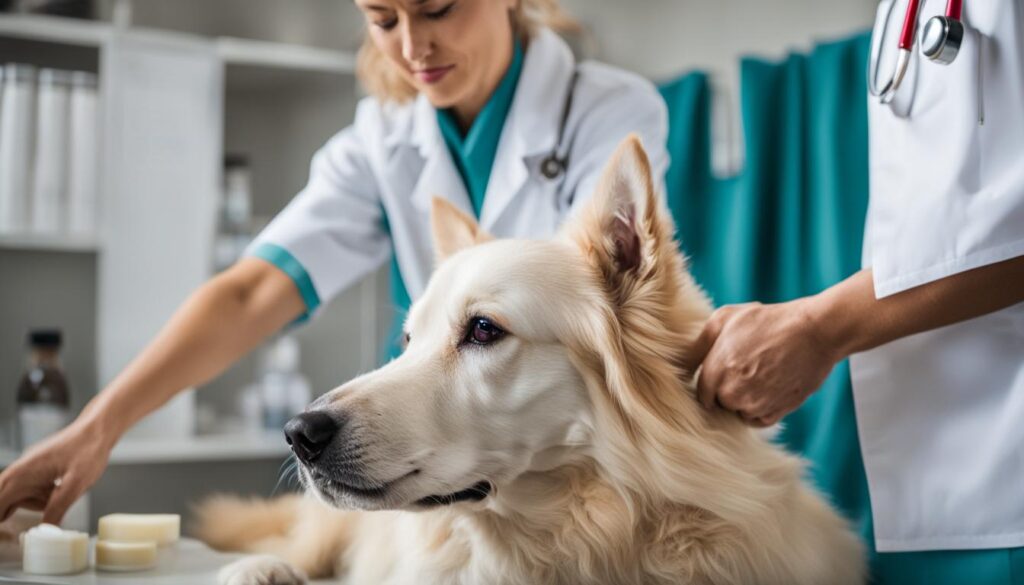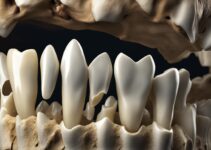As a dog owner, it’s important to be aware of common skin conditions that can affect our furry friends. One such condition is dog seborrhea, also known as seborrheic dermatitis in dogs. This skin condition can be a cause of concern, but with proper understanding and treatment, it can be managed effectively.
Dog seborrhea is characterized by an abnormal production of keratin, a protein responsible for the formation of the skin and hair. It can manifest in two forms: primary and secondary seborrhea. Primary seborrhea is a genetic disease that causes abnormal keratin production, while secondary seborrhea is triggered by underlying health issues such as allergies, hormonal imbalances, vitamin deficiencies, and immune-mediated diseases.
Recognizing the symptoms of seborrhea is essential for early detection and treatment. Dogs with seborrhea may display a dry and dull coat, dandruff, greasy and oily skin with a bad odor, and persistent itching. These symptoms can be discomforting for your furry companion, and it’s crucial to address them promptly.
Treating dog seborrhea involves a holistic approach that targets both the underlying cause and the symptoms. This can include using anti-seborrheic shampoos, regular bathing, ear cleaning, and specific medications tailored to your dog’s needs. By addressing the root cause and implementing a comprehensive treatment plan, you can help your dog find relief and improve their quality of life.
Key Takeaways:
- Dog seborrhea is a skin condition characterized by abnormal keratin production.
- It can manifest as primary or secondary seborrhea, with different underlying causes.
- Symptoms include a dry and dull coat, dandruff, greasy skin with a bad odor, and itching.
- Treatment involves addressing the underlying cause and using anti-seborrheic shampoos, regular bathing, and medication if necessary.
- Regular monitoring by a veterinarian is crucial for managing and improving your dog’s condition.
What is Seborrhea in Dogs?
Seborrhea in dogs is a skin disorder characterized by an abnormal production of keratin, a protein responsible for the formation of the skin and hair. This condition can result in either dry and lackluster coat or greasy and oily skin. There are two types of seborrhea: primary and secondary. Primary seborrhea is a genetic disease that leads to the overproduction of abnormal keratin, while secondary seborrhea is caused by underlying health issues such as hormonal imbalances, allergies, vitamin deficiencies, and immune-mediated diseases.
Primary Seborrhea
Primary seborrhea is inherited and often seen in specific breeds like American Cocker Spaniels, West Highland White Terriers, English Springer Spaniels, and Basset Hounds. It is a lifelong condition that requires consistent management. Dogs with primary seborrhea usually have a combination of dry and oily skin, along with other symptoms such as dandruff and itching. The abnormal production of keratin disrupts the skin’s natural balance and leads to the manifestation of seborrhea.
Secondary Seborrhea
Secondary seborrhea, on the other hand, is caused by various underlying health issues. These may include hormonal imbalances, allergies to food or environmental factors, vitamin deficiencies, immune-mediated diseases, and skin allergies to fleas. The presence of these conditions affects the normal production of keratin and the overall health of the skin, leading to seborrhea symptoms. It is essential to identify and address the underlying cause to effectively manage secondary seborrhea in dogs.
Symptoms of Dog Seborrhea
Dogs with seborrhea can exhibit various symptoms that indicate the presence of this skin condition. Common signs of seborrhea in dogs include:
- Dry and dull coat: The dog’s fur may appear lackluster, with a rough texture and a lack of natural shine.
- Dandruff: Flaky skin and the presence of white or yellowish scales on the dog’s coat, which may be particularly noticeable when brushing or petting the dog.
- Greasy skin: Some dogs with seborrhea may have excessively oily and greasy skin, often accompanied by a distinct unpleasant odor.
- Itching: Dogs with seborrhea often experience itchiness, leading to scratching, licking, and biting at the affected areas.
Seborrhea typically affects the entire skin, but it is often more severe in areas with excessive skin folds, such as the armpits, belly, perineum, and neck. Breeds with many skin folds, like Basset Hounds, are particularly prone to seborrhea in these regions.

Other Possible Symptoms
While the symptoms mentioned above are the most common indicators of seborrhea in dogs, additional signs may be present depending on the severity and underlying causes. These can include crusty and scaly skin lesions, redness, inflammation, and secondary skin infections caused by excessive scratching and bacterial or yeast overgrowth.
If your dog shows any of these symptoms, it is important to consult with a veterinarian for an accurate diagnosis and appropriate treatment.
Causes of Dog Seborrhea
Seborrhea in dogs can have both primary and secondary causes. Primary seborrhea is a genetic condition that is often seen in certain breeds such as American Cocker Spaniels, West Highland White Terriers, English Springer Spaniels, and Basset Hounds. These breeds have a predisposition to overproduction of abnormal keratin, which leads to seborrhea. On the other hand, secondary seborrhea is caused by underlying health issues and can affect dogs of any breed.
Secondary seborrhea can have various causes, including hormonal imbalances, allergies, vitamin deficiencies, immune-mediated diseases, skin allergies to fleas, food, and environmental factors, hypothyroidism, Cushing’s disease, diabetes mellitus, mites and lice, autoimmune diseases, and certain types of cancer. Identifying and addressing the underlying cause of secondary seborrhea is crucial for effective treatment and management of the condition.
It’s important to note that the causes of seborrhea can be complex, and in many cases, multiple factors may contribute to the development of the condition. A thorough examination by a veterinarian, along with diagnostic tests such as skin scraping, cytology, blood tests, and biopsies, may be necessary to determine the specific cause of seborrhea in a dog. Once the cause is identified, appropriate treatment can be recommended to alleviate the symptoms and improve the dog’s overall skin health.
Diagnosing Dog Seborrhea
Diagnosing seborrhea in dogs involves a comprehensive evaluation by a veterinarian. This typically begins with a thorough physical examination of the dog’s skin and coat. The veterinarian may perform various diagnostic tests to determine the underlying cause of the seborrhea.
One common diagnostic procedure is skin scraping, which involves gently scraping the surface of the skin to collect samples that can be examined under a microscope. This helps identify the presence of mites, lice, or other parasites that may be contributing to the seborrhea.
Impression cytology is another useful diagnostic test. It involves taking a small sample of cells from the skin or affected area and examining them under a microscope. This can help identify any yeast or bacterial infections that could be causing or exacerbating the seborrhea.
In some cases, blood tests may be necessary to check for hormonal imbalances, diabetes, or other underlying health issues that may be associated with seborrhea. A biopsy, which involves taking a small tissue sample from the affected area, may also be performed to look for autoimmune diseases or cancer.
Summary
Diagnosing seborrhea in dogs requires a combination of physical examination and diagnostic tests. Skin scraping and impression cytology help identify parasites and infections, while blood tests and biopsies can reveal underlying health issues. These diagnostic procedures help veterinarians determine the underlying cause of seborrhea and guide the appropriate treatment plan.
Treating Dog Seborrhea
When it comes to treating dog seborrhea, the key is to address both the underlying cause and the symptoms of the condition. By doing so, we can effectively manage seborrhea and improve the quality of life for our furry friends.
The first step in treatment is to identify and treat the underlying cause of seborrhea. This may involve addressing hormonal imbalances, allergies, vitamin deficiencies, or other health issues that contribute to the condition. By targeting these underlying factors, we can help reduce the frequency and severity of seborrhea flare-ups.
In addition to treating the underlying cause, managing the symptoms of seborrhea is also important. This can be done using anti-seborrheic shampoos that contain ingredients like coal tar and salicylic acid. These shampoos help to control the excessive oil production and scaling associated with seborrhea, leaving the coat and skin cleaner and healthier.
Regular bathing and ear cleaning are also essential for managing seborrhea. Bathing with anti-seborrheic shampoos helps to remove excess oil and scale from the skin, while ear cleaning helps to prevent ear infections that can accompany seborrhea. Following a consistent bathing and ear cleaning routine can greatly improve the overall comfort and well-being of dogs with seborrhea.
Recovery and Management of Dog Seborrhea
Managing seborrhea in dogs requires a lifelong routine that includes regular bathing and ear cleaning. While seborrhea cannot be completely cured, symptoms can be effectively managed with consistent care and attention.
To help your dog recover from seborrhea, it is important to identify and address the underlying cause. This may involve treating hormonal imbalances, allergies, or other health issues that contribute to seborrhea. Additionally, using anti-seborrheic shampoos and specific medications as prescribed by your veterinarian can help control the condition.
Establishing a regular bathing routine with anti-seborrheic shampoos is crucial for managing seborrhea. These shampoos are specially formulated to reduce excess oiliness or dryness and improve the overall health of the skin and coat. Remember to follow your veterinarian’s recommendations for bathing frequency and techniques to avoid over-drying or irritating the skin.
Regular ear cleaning is also important as seborrhea can affect the ears, leading to discomfort and infections. Your veterinarian can advise you on the appropriate ear cleaning products and techniques to use. By maintaining a consistent bathing and ear cleaning routine, you can help manage seborrhea and improve your dog’s quality of life.
Overview of Canine Seborrhea
Canine seborrhea is a common skin condition that affects dogs, leading to the accumulation of flakes, scales, and crusty plaques on their skin. It can manifest as either dry seborrhea (seborrhea sicca), oily seborrhea (seborrhea oleosa), or a combination of both. Dogs with seborrhea may experience symptoms such as a dry and dull coat, dandruff, greasy and oily skin, itching, and secondary infections.
There are two main types of seborrhea in dogs: primary and secondary. Primary seborrhea is a hereditary condition that is often seen in specific breeds. On the other hand, secondary seborrhea is caused by underlying health issues such as hormonal imbalances, allergies, vitamin deficiencies, immune-mediated diseases, and skin allergies to fleas, food, or environmental factors.
The treatment for canine seborrhea involves addressing the underlying cause and managing the symptoms. Identifying and treating any underlying health issues is crucial to controlling seborrhea. Additionally, the use of anti-seborrheic shampoos, regular bathing, and ear cleaning can help manage the condition. In some cases, medication may be prescribed to manage inflammation and infections.
Symptoms, Causes, and Treatment
When it comes to seborrhea in dogs, it is important to recognize the symptoms, understand the underlying causes, and implement the appropriate treatment. Symptoms of seborrhea can vary depending on the type and severity of the condition but may include dry and dull coat, dandruff, greasy and oily skin, itching, and secondary infections.
The causes of seborrhea can be genetic or related to underlying health issues. Primary seborrhea is often hereditary and more common in certain breeds, while secondary seborrhea can be caused by hormonal imbalances, allergies, vitamin deficiencies, immune-mediated diseases, and other factors. Treating the underlying cause is essential in managing seborrhea in dogs.
Treatment options for seborrhea in dogs include addressing the underlying cause, using anti-seborrheic shampoos, regular bathing, ear cleaning, and, in some cases, medication to manage inflammation and infections. It is important to work closely with a veterinarian to develop a comprehensive treatment plan tailored to each individual dog’s needs.
Diagnosis and Treatment of Seborrhea in Dogs
Diagnosing seborrhea in dogs requires a comprehensive evaluation of the skin and may involve various diagnostic tests. Skin scrapings can help identify the presence of mites or lice, while cytology can detect yeast or bacterial infections. Biopsies may be performed to investigate autoimmune diseases or cancer. Additionally, blood tests can provide valuable insights into hormonal imbalances, diabetes, and Cushing’s disease. These diagnostic procedures help determine the underlying cause of seborrhea, guiding the appropriate treatment plan.
The treatment for seborrhea in dogs focuses on addressing the underlying issues and managing the symptoms. Treating the underlying cause involves addressing allergies, hormonal imbalances, infections, or other health issues that contribute to seborrhea. Anti-seborrheic shampoos containing ingredients like coal tar and salicylic acid can be used to alleviate symptoms. In some cases, corticosteroids, supplements, or other medications may be prescribed to manage inflammation and infections. Regular monitoring and management are essential to keep the condition under control.
Management and Ongoing Care
Managing seborrhea in dogs requires a lifelong routine that includes regular bathing with anti-seborrheic shampoos and proper ear cleaning. It is important to note that seborrhea cannot be completely cured, but with consistent care, the symptoms can be controlled. It may take several weeks for the symptoms to improve, and ongoing communication and follow-up with a veterinarian are crucial. By maintaining a management plan, dogs with seborrhea can lead a comfortable and healthy life.

Ensuring the well-being of dogs with seborrhea requires a comprehensive approach to diagnosis, treatment, and ongoing care. By identifying the underlying cause and providing appropriate treatment, along with regular monitoring and management, the symptoms of seborrhea can be effectively managed. With proper care, dogs with seborrhea can enjoy an improved quality of life.
Cost and Prevention of Seborrhea in Dogs
When it comes to treating seborrhea in dogs, the cost can vary depending on the specific diagnostic tests, medications, and treatments required. Diagnostic procedures such as skin scrapings, cytology, and biopsies can add up, especially if multiple tests are needed to determine the underlying cause of the seborrhea. Additionally, ongoing management and maintenance of the condition may involve regular veterinary visits, which can also contribute to the overall cost.
It’s important to keep in mind that managing seborrhea in dogs is a lifelong commitment, and this includes both financial and time investments. The cost of veterinary care, including visits, tests, and medications, should be considered when budgeting for the treatment and management of seborrhea in your dog.
As much as we would like to prevent seborrhea in dogs, there is currently no known way to completely prevent this condition. However, there are steps that can be taken to minimize the risk and severity of seborrhea. One of the most important factors in preventing seborrhea is careful breeding practices. Breeders should prioritize breeding dogs with no history of primary seborrhea, especially in breeds that are predisposed to this condition. Regular grooming and hygiene practices, such as bathing and ear cleaning, can also help maintain the overall health of your dog’s skin and decrease the likelihood of seborrhea.
Image
While there may not be a surefire way to prevent seborrhea, by being proactive and responsive to your dog’s overall health and skincare needs, you can minimize the impact of seborrhea and ensure your furry friend has the best possible quality of life.
Conclusion
As I conclude this article on dog seborrhea, it is evident that this common skin condition can be effectively managed to ensure a good quality of life for affected dogs. By understanding the underlying causes and implementing a comprehensive treatment plan, we can help alleviate the symptoms and reduce discomfort.
Managing seborrhea involves addressing the primary or secondary causes that contribute to the condition. This may involve treating hormonal imbalances, allergies, or infections, as well as regular bathing with anti-seborrheic shampoos and ear cleaning. Additionally, medication may be necessary to manage inflammation and infections.
It’s important to remember that seborrhea cannot be cured completely, but with proper management, dogs can experience significant improvement. Regular monitoring by a veterinarian is crucial to ensure that the treatment plan is effective and any necessary adjustments are made promptly. With the right care, dogs with seborrhea can lead happy and comfortable lives.
FAQ
What is dog seborrhea?
Dog seborrhea is a skin disorder characterized by an abnormal production of keratin, a protein that is responsible for the formation of the skin and hair. It can result in dry and lackluster coat or greasy and oily skin.
What are the symptoms of dog seborrhea?
Symptoms of dog seborrhea include dry and dull coat, dandruff, greasy and oily skin with a bad odor, and itching. Dogs may also develop crusty and scaly skin lesions.
What causes dog seborrhea?
Dog seborrhea can be primary, which is a genetic disease that causes abnormal keratin production, or secondary, which is caused by underlying health issues such as hormonal imbalances, allergies, vitamin deficiencies, and immune-mediated diseases.
How is dog seborrhea diagnosed?
Dog seborrhea is diagnosed through a thorough physical examination by a veterinarian. Additional diagnostic tests may include skin scraping, impression cytology, blood tests, and biopsy to determine the underlying cause.
How is dog seborrhea treated?
Treatment for dog seborrhea involves addressing the underlying cause and managing the seborrhea itself. This may include using anti-seborrheic shampoos, regular bathing, ear cleaning, and specific medications as prescribed by a veterinarian.
Can dog seborrhea be cured?
Seborrhea cannot be cured completely, but symptoms can be managed with lifelong routines such as regular bathing with anti-seborrheic shampoos, ear cleaning, and in some cases, medication.
How much does treating dog seborrhea cost?
The cost of treating dog seborrhea can vary depending on the diagnostic tests, medications, and treatments required. Diagnostic procedures and ongoing management may involve regular vet visits and medication expenses.
Is there a way to prevent dog seborrhea?
There is no known way to prevent dog seborrhea except for careful breeding practices to avoid primary seborrhea in certain breeds.



